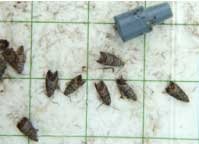While mating disruption (MD) for codling moth and oriental fruit moth is declining in Australian, in the US and Europe it is increasing each year. CONTINUED FROM LAST ISSUE: Pheromone trials
Pheromone trials
Combo dispenser trials
Studies were conducted with hand-applied combo dispensers loaded with codlemone (sex pheromone) together with pear ester for control of codling moth.
Two rates of combo dispensers were tested and compared with dispensers loaded only with codlemone. The CM Combo dispensers were applied at 800 per hectare.
CM Meso Combo dispensers were applied at 80 per hectare, and were loaded with 10 times the rates of each component in the same ratio.
Findings
Initial findings suggest that no significant differences were found among the three treatments in the mean levels of fruit injury.
However, the mating status of trapped females, and the total female moth catches in traps baited with a codlemone and pear ester combo lure (with an acetic acid co-lure) in the second half of the field season, did vary between treatments.
Blocks treated with the CM Meso dispensers had significantly higher levels of un-mated females and had significantly lower levels of fruit injury than the other two dispenser treatments during the first moth flight period.
In addition, combo lures loaded with codlemone and either pear ester or (E)-4,8-dimethyl-1,3,7-nonatriene (and used with acetic acid co-lures) caught similar numbers of total and female moths in blocks treated with either combo dispenser.
What does it all mean?
Pear ester
In summary, the pear ester as a monitoring lure (Duo lures) or as a MD component, has not performed consistently in different fruit production areas, or in different varieties of apples and especially pears.
The pear ester is a volatile scent from a ripening pear. The attractiveness of this scent to a female codling moth depends on her history (apple or pear inclined) and the attractiveness of this scent to her.
Pear ester is one of a large number of scents and aromas from pears, the complexity of these esters is vast.
The ripening of fruit during the second or third flight of the codling moth may also be a factor that may interfere with the attractiveness of the pear ester lure to the moths at that time.
New lures for monitoring
There is a lot of work developing new lures for monitoring codling moth in MD blocks.
The following six components were found in apples to give female codling moth a response: acetic acid co-attractant; Nonanal; 4,8-dimethyl-1,3, (E)7-nonatriene; methyl salicylate; decanal; Z,E-a-farnesene; E,E-a-farnesene.
These components are being tested for their attractiveness to female and male codling moth.
This new apple-pear ester host kairomone blend is more potent than pear ester for monitoring female codling moth, and is more environmentally friendly and easier to handle than the pear ester–acetic acid combination lure.
Range of new lures expected
We will see a range of lures coming onto the market with various combinations of ingredients for monitoring codling moth in MD blocks.
The lures will vary in their performance between fruit growing areas and fruit varieties.
The advantage of this work is that we will have more sensitive lures for monitoring codling moth.
With current 10x lures, there are times when no codling moths are caught in monitoring traps, yet there are stings in the orchard.
With the increased sensitivity and attractiveness of these new lures, they should provide a clearer appreciation of the codling moth dynamics in orchards.
It will be vital to understand what the performance of these lures means. The numbers of moths caught is a major threshold for action. But with a new type of lure, what do the trap numbers mean?
Only time will tell, it will take a number of seasons to compare different lures and the sensitivity of the female codling moth to these blends.
For more information, see Tree Fruit September 2013




















